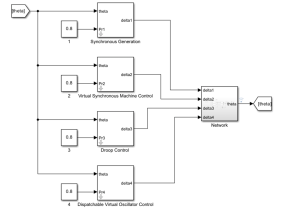Reduced-Order Modeling of Inverter and Synchronous Generator based Power Networks
MS student Ethan Wllliams with Advisor A. D. Domínguez-García.
Stability has become an increasing concern with the growing penetration of renewable energy sources into power systems because of the decrease in system inertia as synchronous generation is replaced by inverter-based generation and other aspects. Specifically, given the wide variety of control strategies implemented for inverter-based resources, each with different control parameters, it is important to investigate how these resources interact amongst each other and with synchronous resources. When studying full-order models, it is difficult to gain an analytical or intuitive understanding of the dominant factors for stability due to the complex models needed for each resource. However, with reduced-order models, in which dynamic phenomena are occurring at slower and faster time scales than the scale of interest are ignored, it is easier to analytically study power systems with both synchronous and inverter-based generation. Thus, a reduced-order analysis framework for studying generic power systems with generation from inverters with droop control, virtual synchronous machine control, and dispatchable virtual-oscillator control, along with generation from synchronous machines, has been developed. Further, non-linear and linear models of the generic power system have been constructed in Simulink (non-linear model pictured in Fig. 1). This was done both to validate the linearized model and provide a testbed for studying such power systems. In further work, this model will be utilized for small-signal stability analyses, and sensitivity studies will be performed on parameters associated with the different generation sources. Additionally, this model will be utilized for design and tuning of control systems incorporated with these generation sources. This research is supported by PSERC.
